logistic regression
1/25
There's no tags or description
Looks like no tags are added yet.
Name | Mastery | Learn | Test | Matching | Spaced |
|---|
No study sessions yet.
26 Terms
generative classifiers + discriminative
if distinguishing cat from dog images = generative classifier
build a model of what’s in a cat image
whiskers, eyes ears
assigns prob to any image to determine how cat-like is that image?
similarly, build model of what’s in dog image
now given new image, run both + see which fits better
If we are distinguishing cat from dog images using a Discriminative Classifier.
• Just try to distinguish dogs from cats. Oh look, dogs have collars. - Let’s ignore everything else.
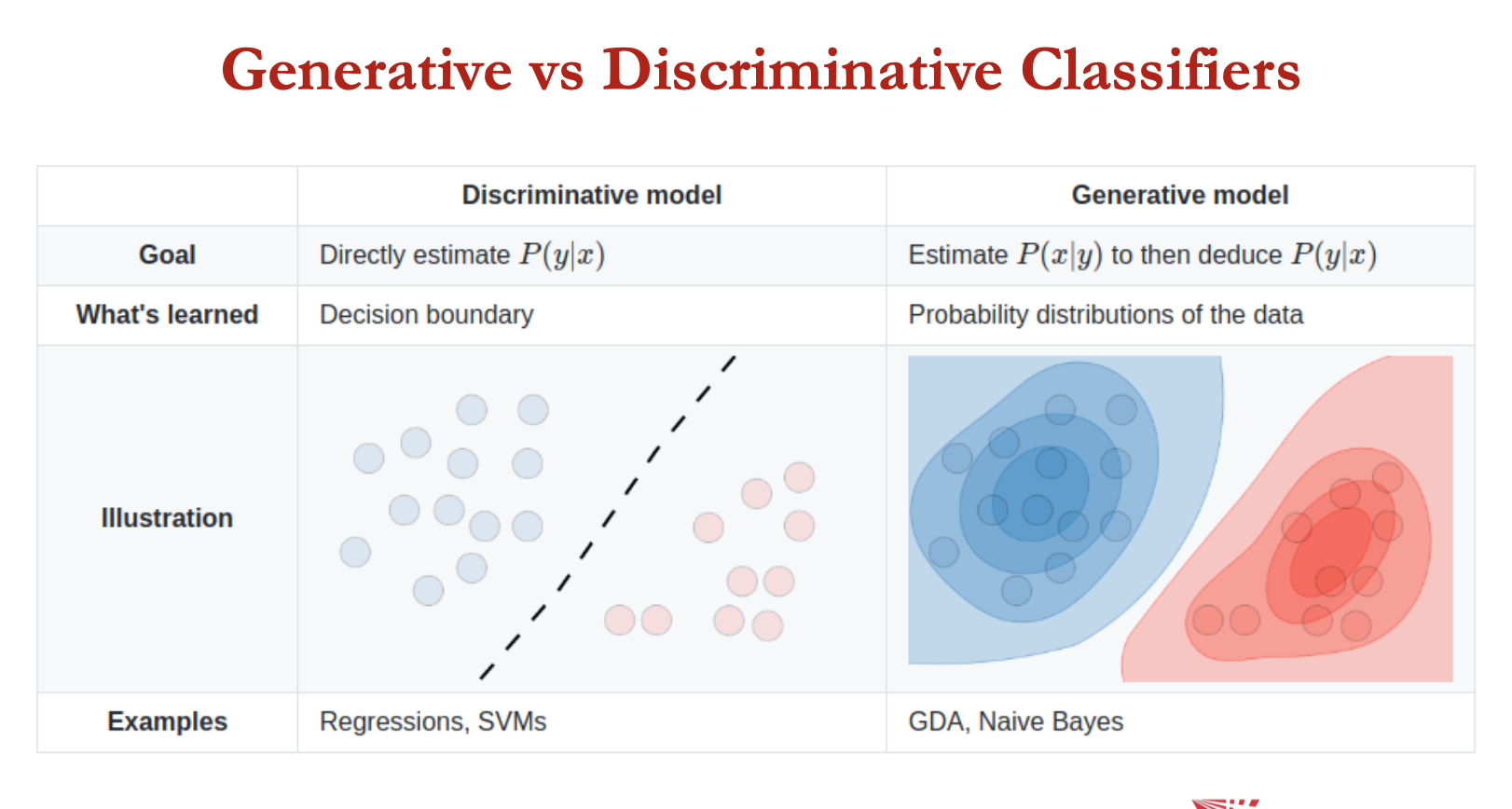
generative vs discriminative classifiers
generative (naive bayes)
assume some form of conditional independence
estimate parameters of P(D|h), P(h) directly from training data
use bayes rule to calculate P(h|D)
why not learn P(h|D) or decision boundary directly?
discriminative (logistic regression)
assume some functional form for P(h|D) or for the decision boundary
estimate parameters of P(h|D) directly from training data
Naïve Bayes:
𝑌𝑁𝐵=𝑎𝑟𝑔𝑚𝑎𝑥h𝑃(𝐷|h) ⋅𝑃(h)
logistic regression:
- 𝑌𝐿𝑅 = 𝑎𝑟𝑔𝑚𝑎𝑥h𝑃(𝐷|h)
learning a LR classifier
given n input-output pairs:
a feature representation of the input. For each input observation x, a vector of features [x1, x2, …, xd]
a classification function that computes y, the estimated class via P(y|x), using the sigmoid or softmax functions
an objective function for learning, e.g. cross-entropy loss
an algo for optimising the objective function - stochastic gradient ascent/descent
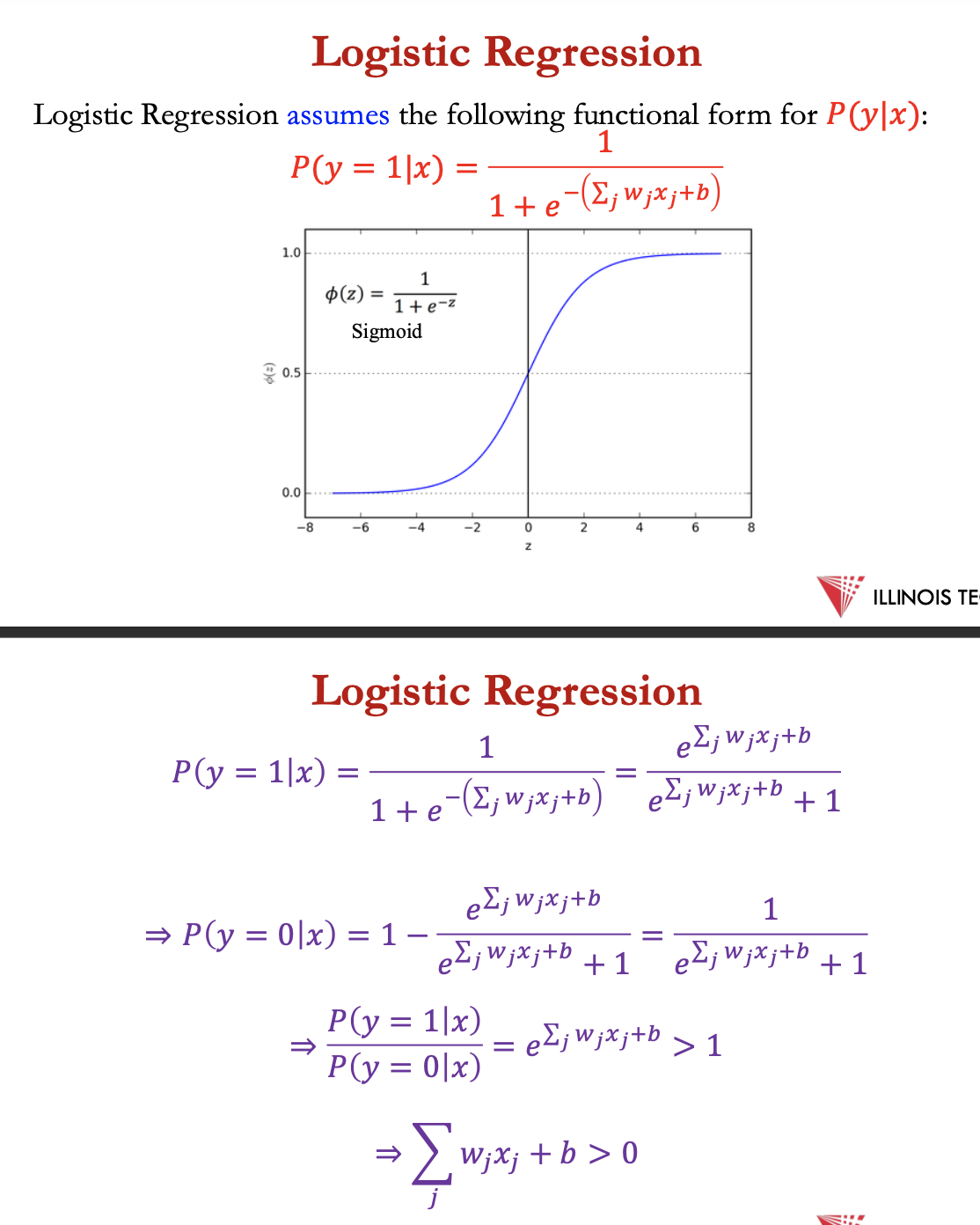
LR
LR assumes the following functional form for P(y|x):
P(y=1|x) = 1/ (1+e ^ (-(∑ j wjxj +b)))
→ ∑ wjxj + b > 0
logistic regression = linear classifier
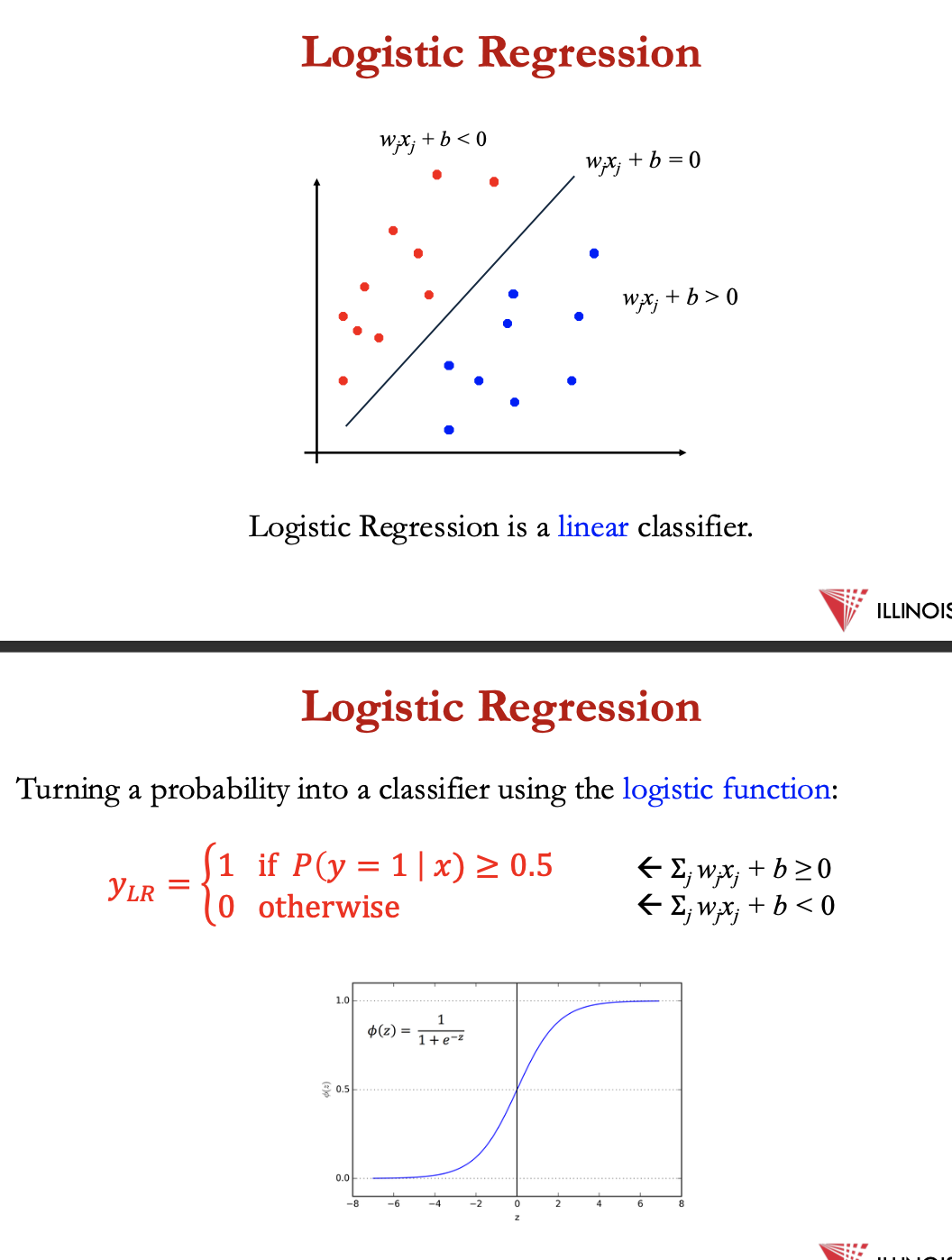
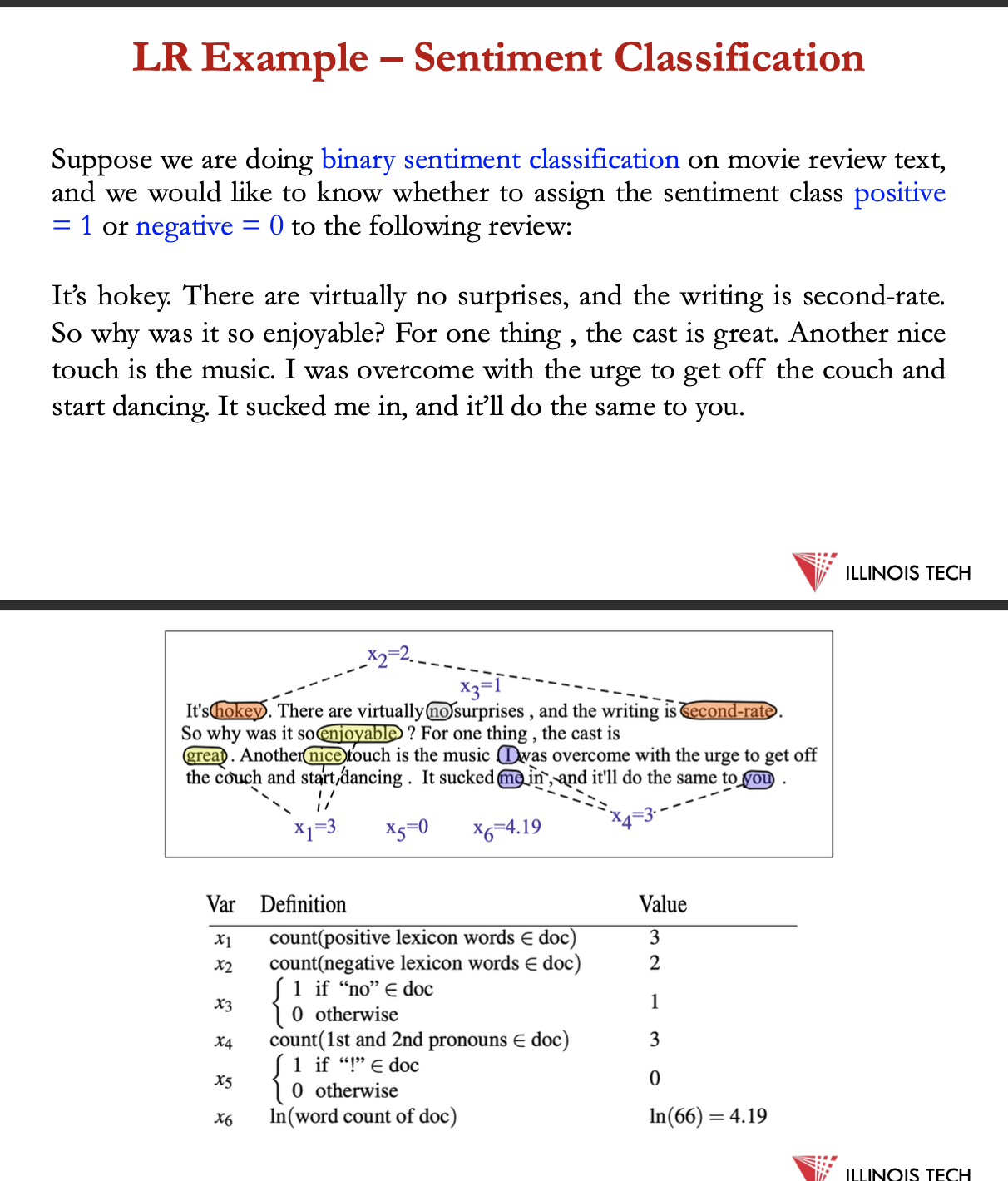
LR example - sentiment classification
e.g. doing binary sentiment classification on movie review test + we’d like to know whether to assign the sentiment class +ve = 1 or -ve = 0 to the following review:
Let’s assume for the moment that we’ve already learned a real-valued weight for each of these features, and that the 6 weights corresponding to the 6 features are [2.5, −5.0, −1.2, 0.5, 2.0, 0.7], while b = 0.1.
![<p>e.g. doing binary sentiment classification on movie review test + we’d like to know whether to assign the sentiment class +ve = 1 or -ve = 0 to the following review:</p><p></p><p><span>Let’s assume for the moment that we’ve already learned a real-valued weight for each of these features, and that the 6 weights corresponding to the 6 features are [2.5, −5.0, −1.2, 0.5, 2.0, 0.7], while <em>b </em>= 0.1.</span></p>](https://knowt-user-attachments.s3.amazonaws.com/06e0f0b2-ff98-4955-b0d7-07ebce94e10b.png)
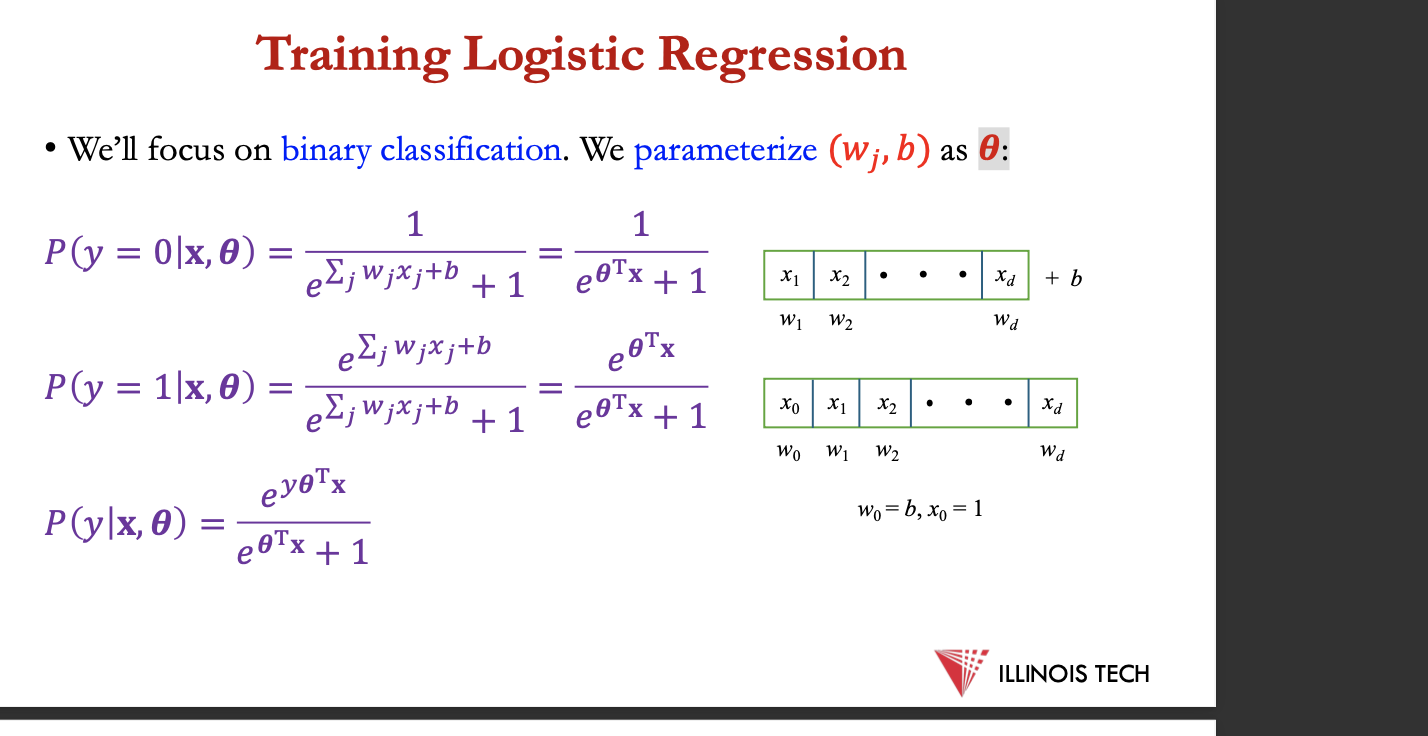
training LR
we’ll focus on binary classification
we parameterise (wj,b) as 𝜽:
p(y| x, 𝜽) = ey𝜽Tx/ e𝜽Tx + 1
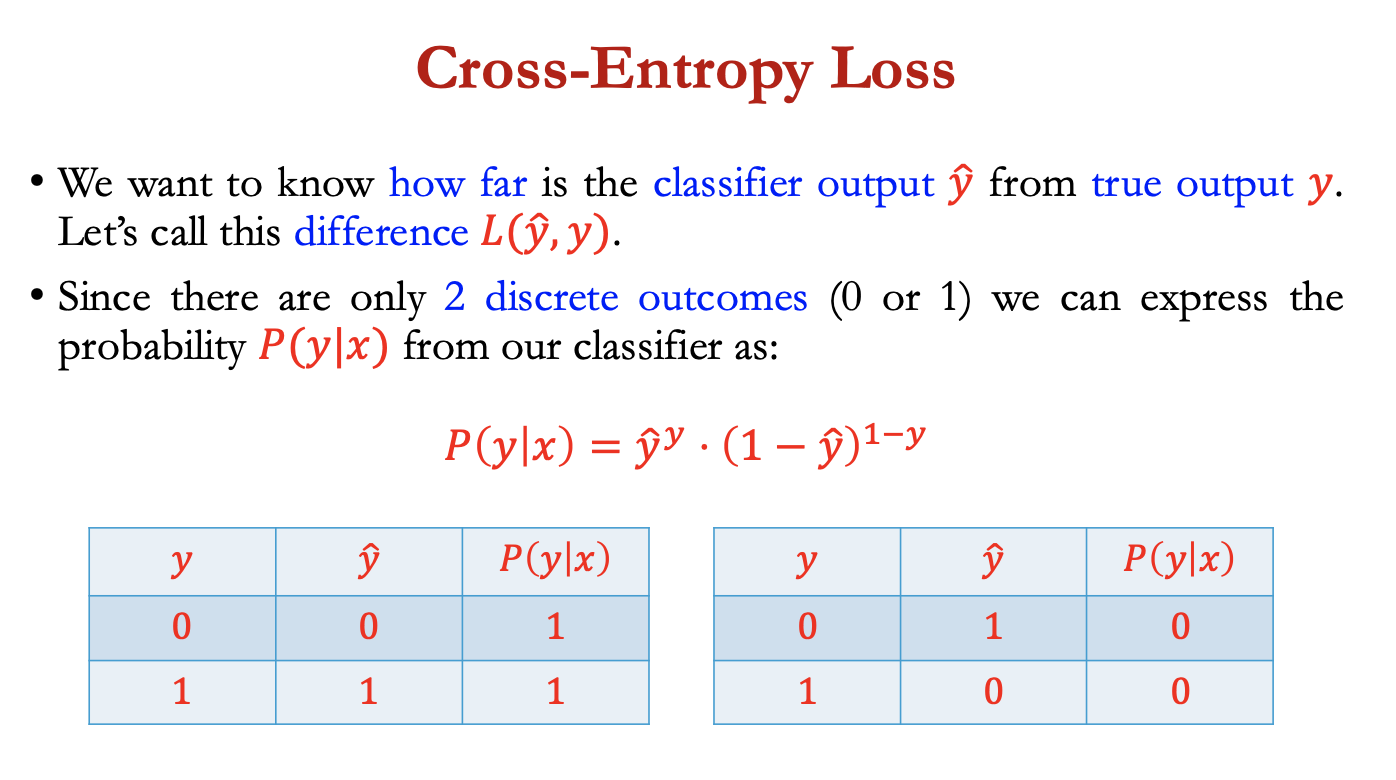
cross entropy loss
want to know how far is classifier output ŷ from true output y , difference = L(ŷ,y)
2 discrete outcomes, can express probability
P(y|x) = ŷy * (1-ŷ)1-y
goal: maximise prob of the correct label P(y|x)
Maximize: P(y|x) = ŷy * (1-ŷ)1-y
Maximize: logP(y|x) =log ( ŷy * (1-ŷ)1-y)
Maximize: logP(y|x) = y log ŷ + (1-y)log (1-ŷ)
want to min. cross entropy loss
= log ( 1+𝑒𝜽T𝐱) −𝑦𝜽T𝐱
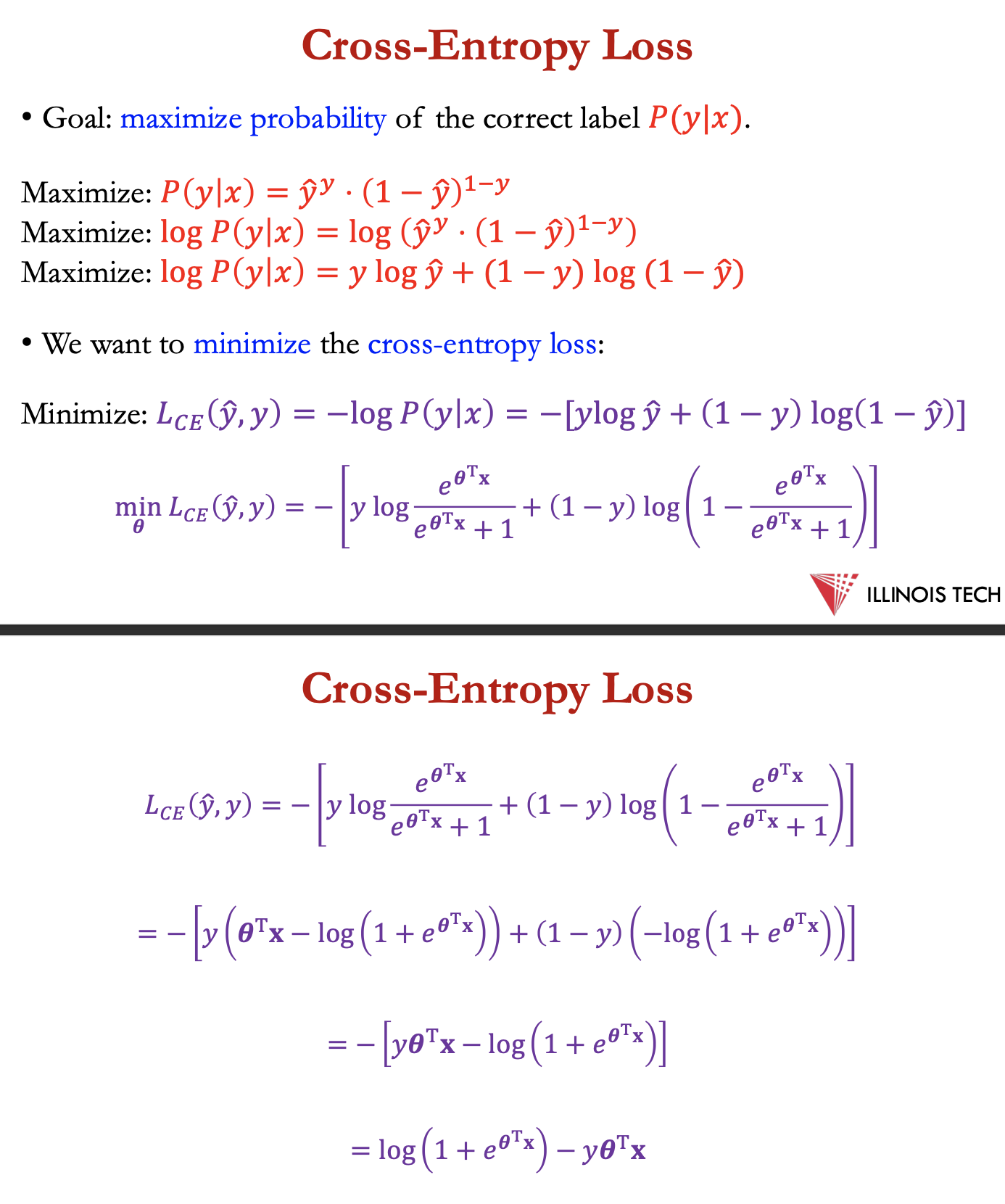
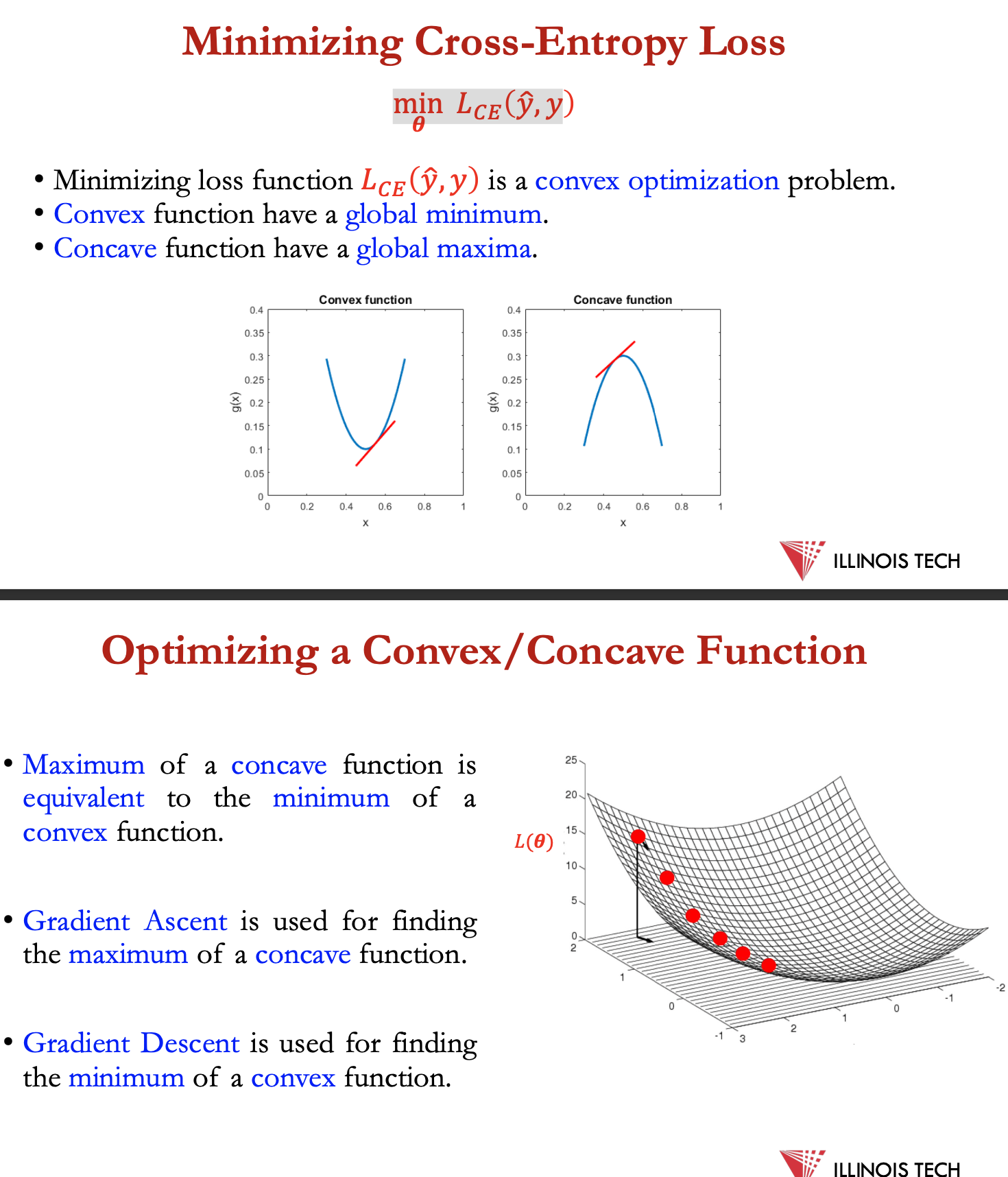
minimising cross entropy loss
min 𝐿 𝐶 𝐸 (ŷ,y)
minimising above = convex optimisation problem
convex function = global min → Gradient Ascent
concave func = global max → Gradient descent
gradients:
gradient of function = vector pointing in direction of the greatest increase in a function
Gradient Ascent: Find the gradient of the function at the current point and move in the same direction.
• Gradient Descent: Find the gradient of the function at the current point and move in the opposite direction.
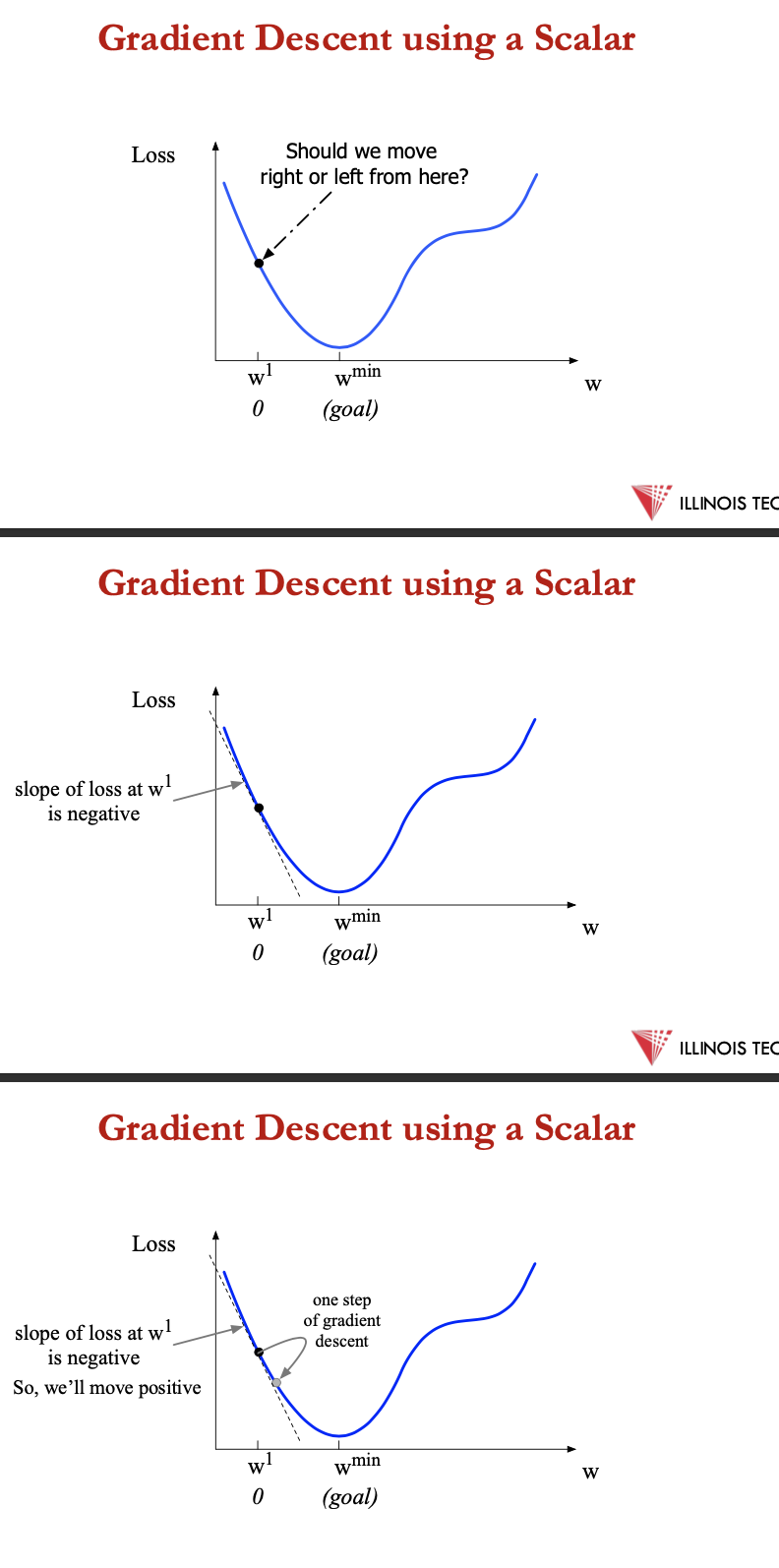
gd for LR
• Let us represent ŷ = 𝑓(𝐱; 𝜽)
𝜽t+1 = 𝜽t - 𝜂 ⋅ 𝐱 [1 / 1+ 𝑒−𝜽T𝐱 - y]
![<p><span>• Let us represent ŷ = 𝑓(𝐱; 𝜽)<br></span></p><p>𝜽<sub>t+1 </sub>= 𝜽<sub>t</sub> - <span>𝜂 ⋅ 𝐱 [1 / 1+ 𝑒<sup>−𝜽T𝐱</sup> - y]</span></p>](https://knowt-user-attachments.s3.amazonaws.com/d7192f76-6ee5-4a28-a416-6e6333e3d8c1.png)
learning rate
𝜂 is a hyperparameter.
• Large 𝜂 ⇒ Fast convergence but larger residual error. Also, possible
oscillations.
• Small 𝜂 ⇒ Slow convergence but small residual error.
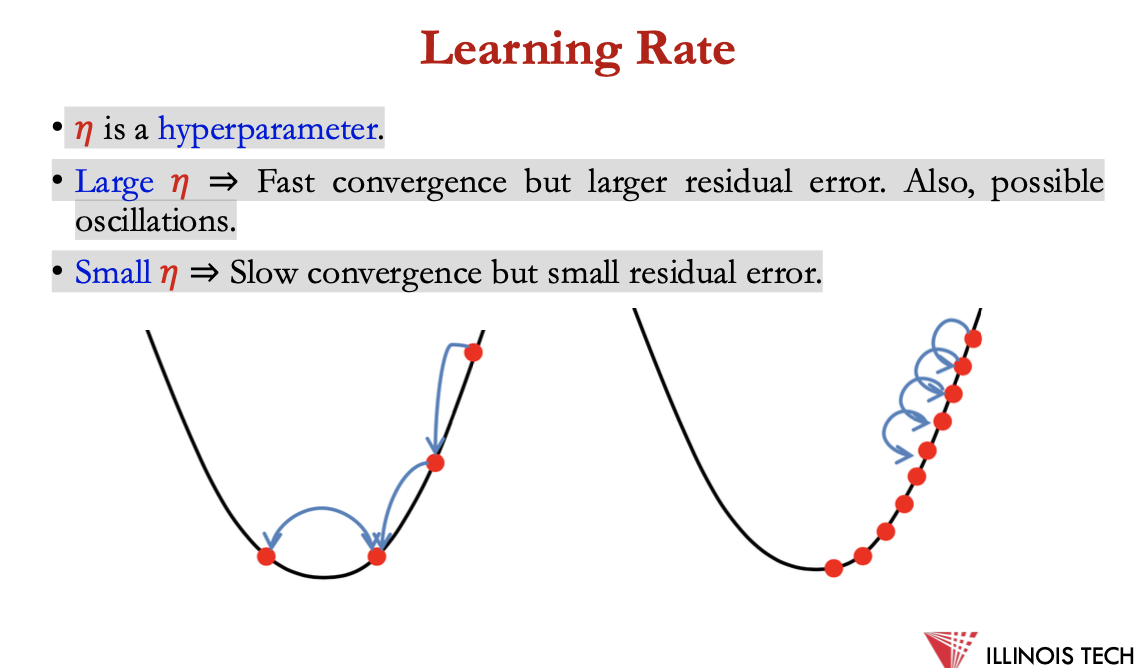
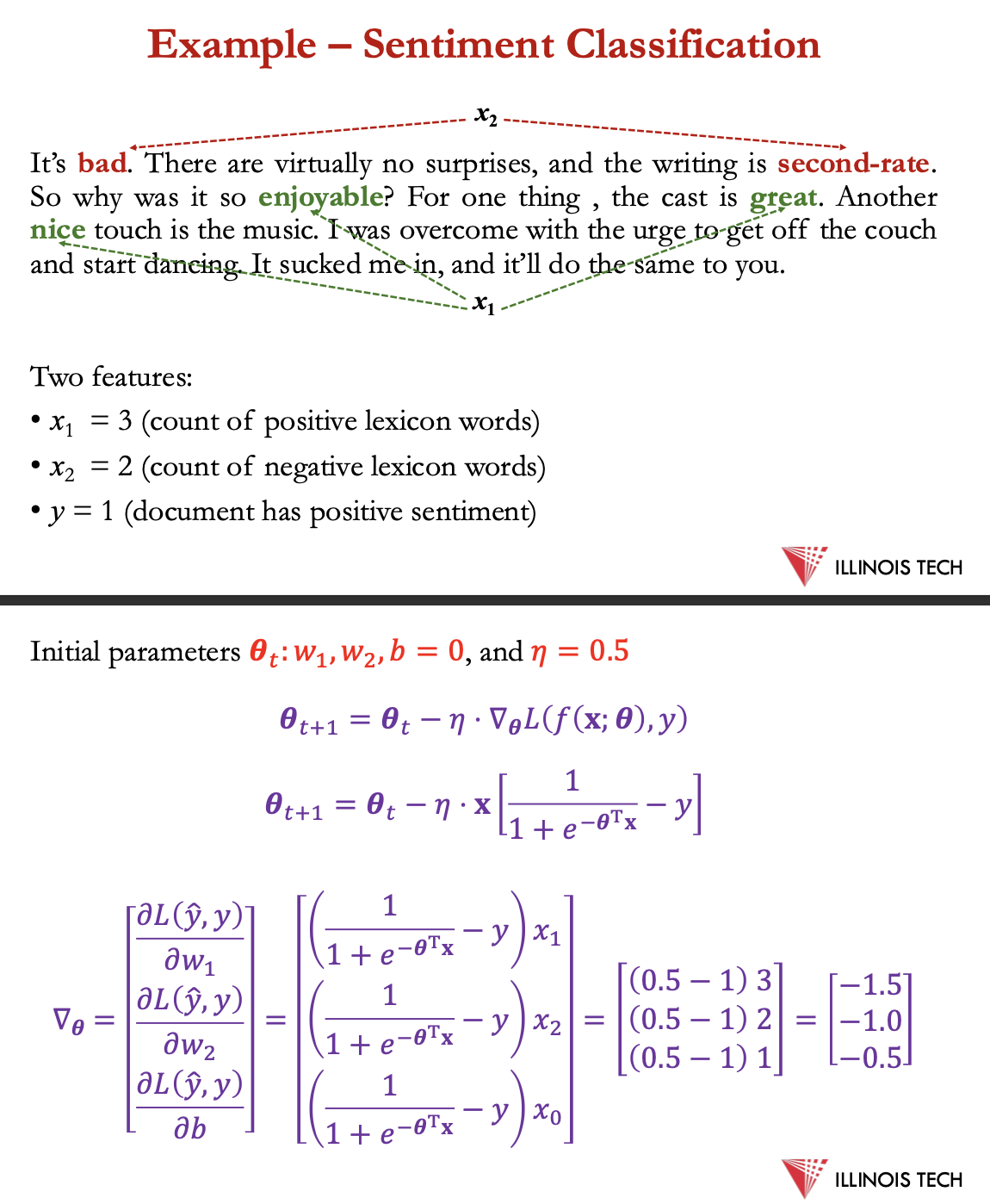
Example – Sentiment Classification
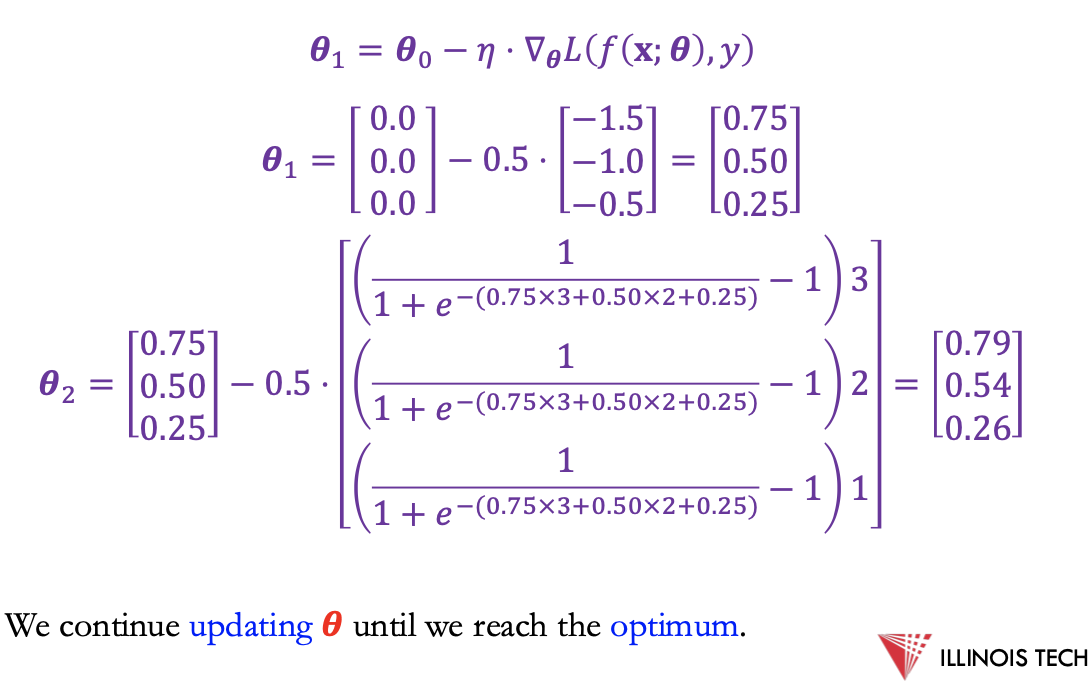
understanding the sigmoid
large weights = overfitting
penalising larger weights can reduce overfitting
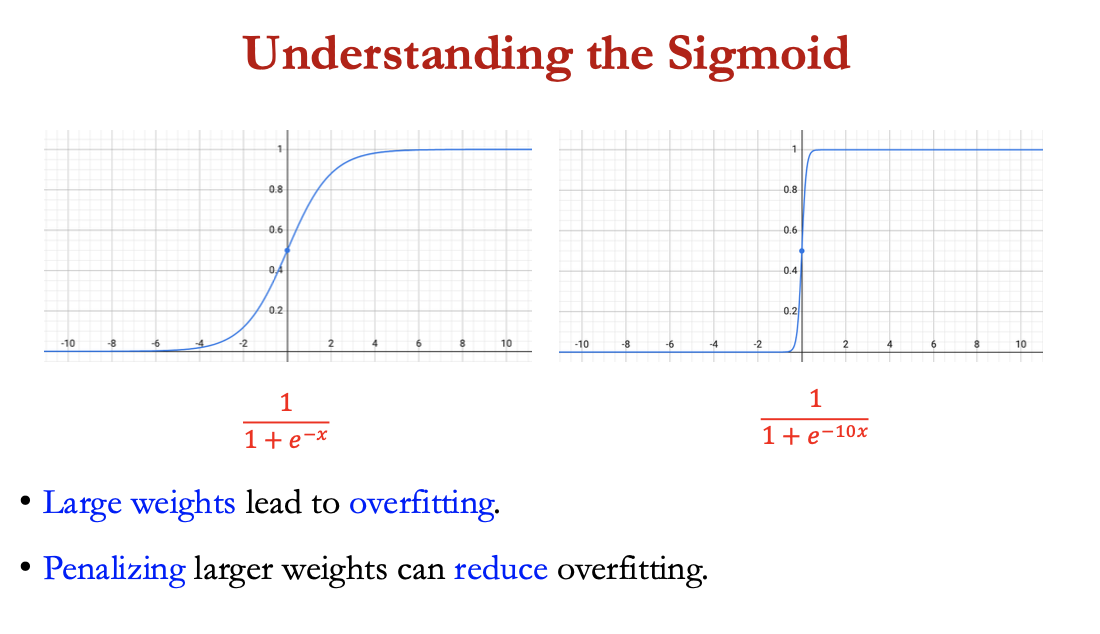
regularisation
used to avoid overfitting
weights for features will attempt to perfectly fit details of the training set, modelling even noisy data that just accidentally correlate with the class = overfitting
good model = generalises well from the training data to the unseen test set, but model that overfits will have poor generalisation
avoid overfitting = add regularisation term 𝑅(𝜽) to the loss function
min 𝐿𝑟𝑒𝑔 (ŷ,y) =min (log (1+𝑒𝜽T𝐱) −𝑦𝜽T𝐱+𝜆𝑅 (𝜽))
more regularisation
L2 regularisation → ridge regression
uses square of the L2 (euclidean) norm of the weight values
𝑅 (𝜽) = ||𝜽 ||22 = ∑𝜽2j
min 𝐿𝑟𝑒𝑔 (ŷ,y) =min (log (1+𝑒𝜽T𝐱) −𝑦𝜽T𝐱+𝜆∑𝜽2j )
L1 regularisation → lasso regression
uses L1 norm (Manhattan distance) of the weight values
𝑅 (𝜽) = ||𝜽 ||1 = ∑|𝜽j|
min 𝐿𝑟𝑒𝑔 (ŷ,y) =min (log (1+𝑒𝜽T𝐱) −𝑦𝜽T𝐱+𝜆∑|𝜽j|)
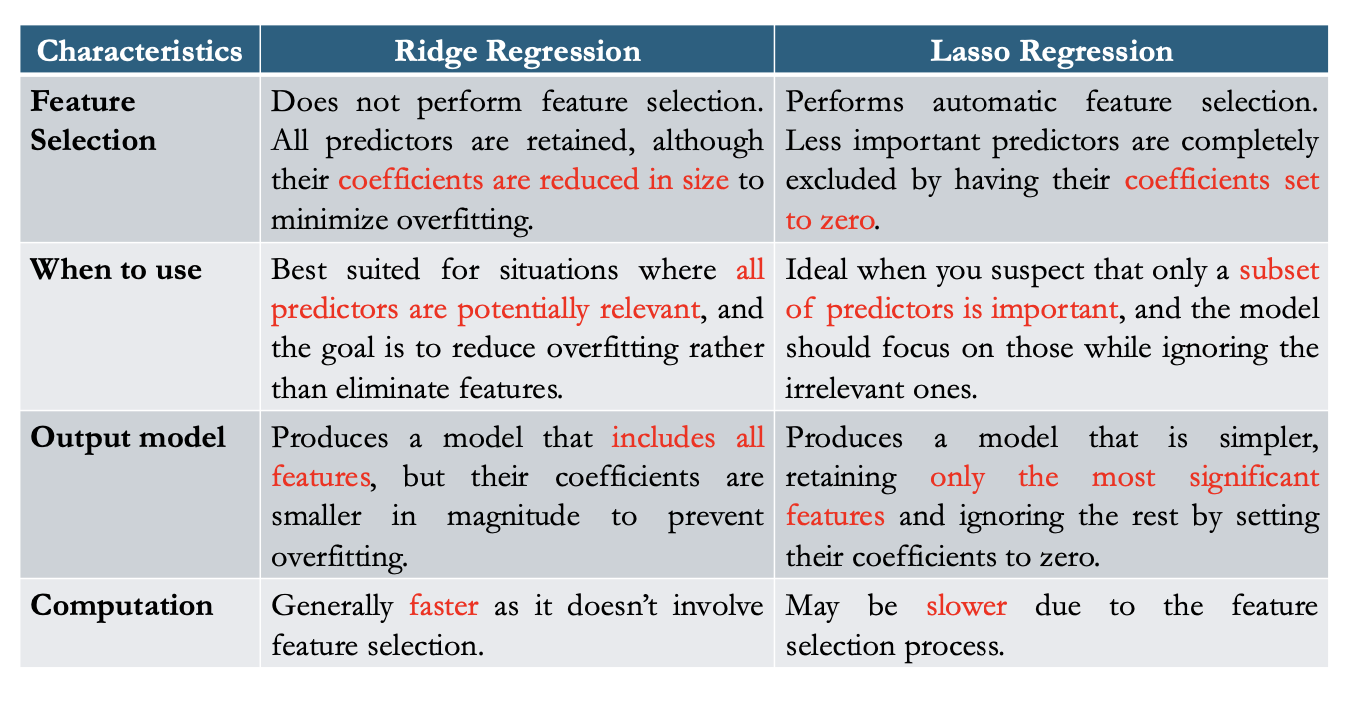
batch training
stochastic g.d. - chooses single random example at a time, moving the weights so as to improve performance on that single example
= choppy movements, common to compute the gradient over batches of training instances over a single instance
training data: {𝑥𝑖 ,𝑦𝑖} 𝑖=1...𝑛 where, 𝑥𝑖 = (𝑥𝑖1 ,𝑥𝑖2 ,...𝑥𝑖𝑑), 𝑛 is the total instances in a batch and 𝑑 is the dimension of an instance
𝜽𝑡+1=𝜽𝑡−𝜂/ 𝑛⋅∑ 𝐱𝑖𝑗 [ 1/ 1+𝑒−𝜽T𝐱−𝑦𝑖]
![<p>stochastic g.d. - chooses single random example at a time, moving the weights so as to improve performance on that single example</p><p>= choppy movements, common to compute the gradient over batches of training instances over a single instance</p><p></p><p>training data: {<span>𝑥𝑖 ,𝑦𝑖} <sub>𝑖=1...𝑛</sub> where, 𝑥𝑖 = (𝑥𝑖1 ,𝑥𝑖2 ,...𝑥𝑖𝑑), 𝑛 is the total instances in a batch and 𝑑 is the dimension of an instance</span></p><p><span>𝜽<sub>𝑡+1</sub>=𝜽</span><sub>𝑡</sub><span>−𝜂/ 𝑛⋅∑ 𝐱<sub>𝑖𝑗</sub> [ 1/ 1+𝑒<sup>−𝜽T𝐱</sup>−𝑦𝑖]</span></p>](https://knowt-user-attachments.s3.amazonaws.com/a49ed856-b890-4d14-a437-789f167d89c8.png)
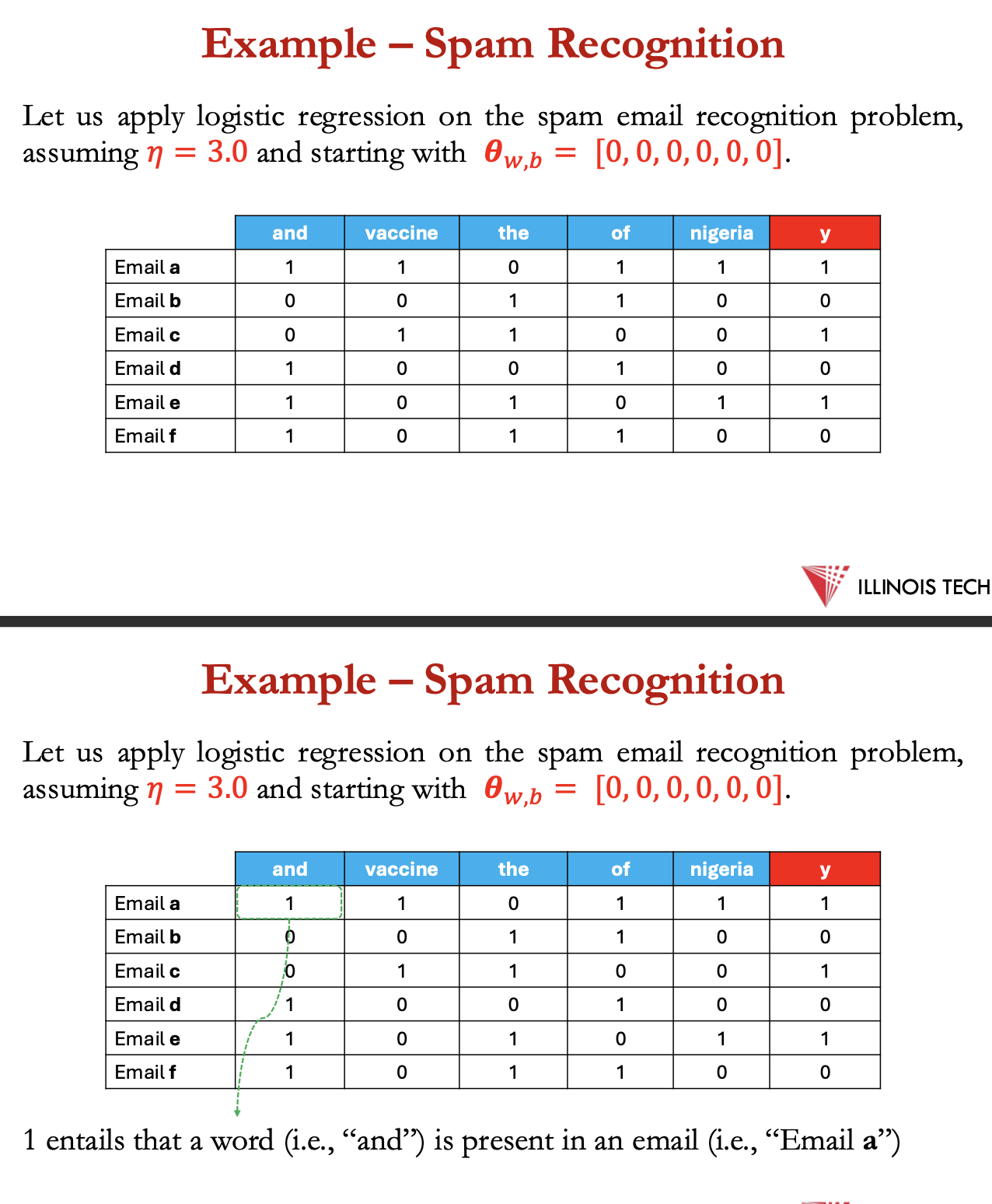
example - spam recognition
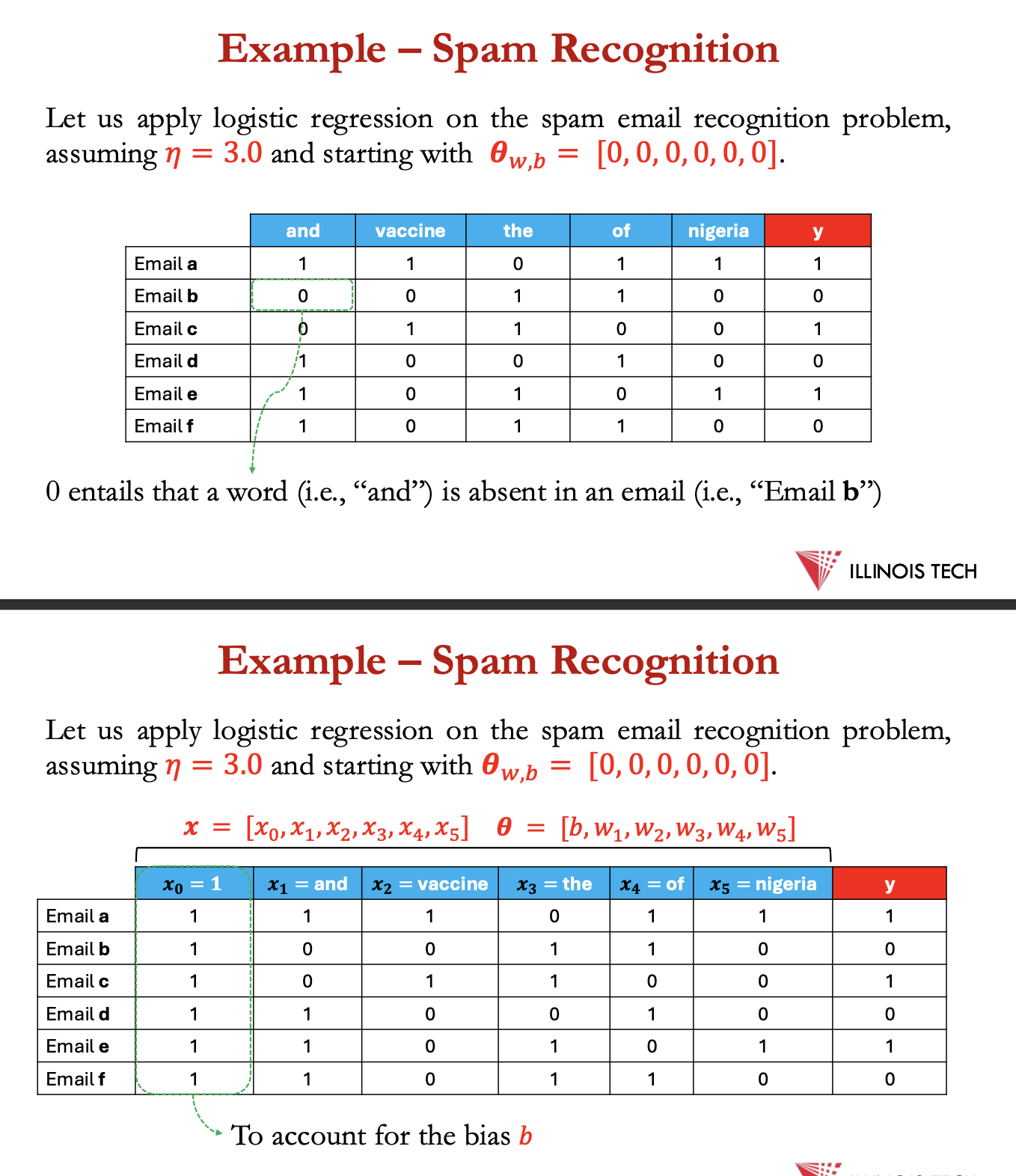
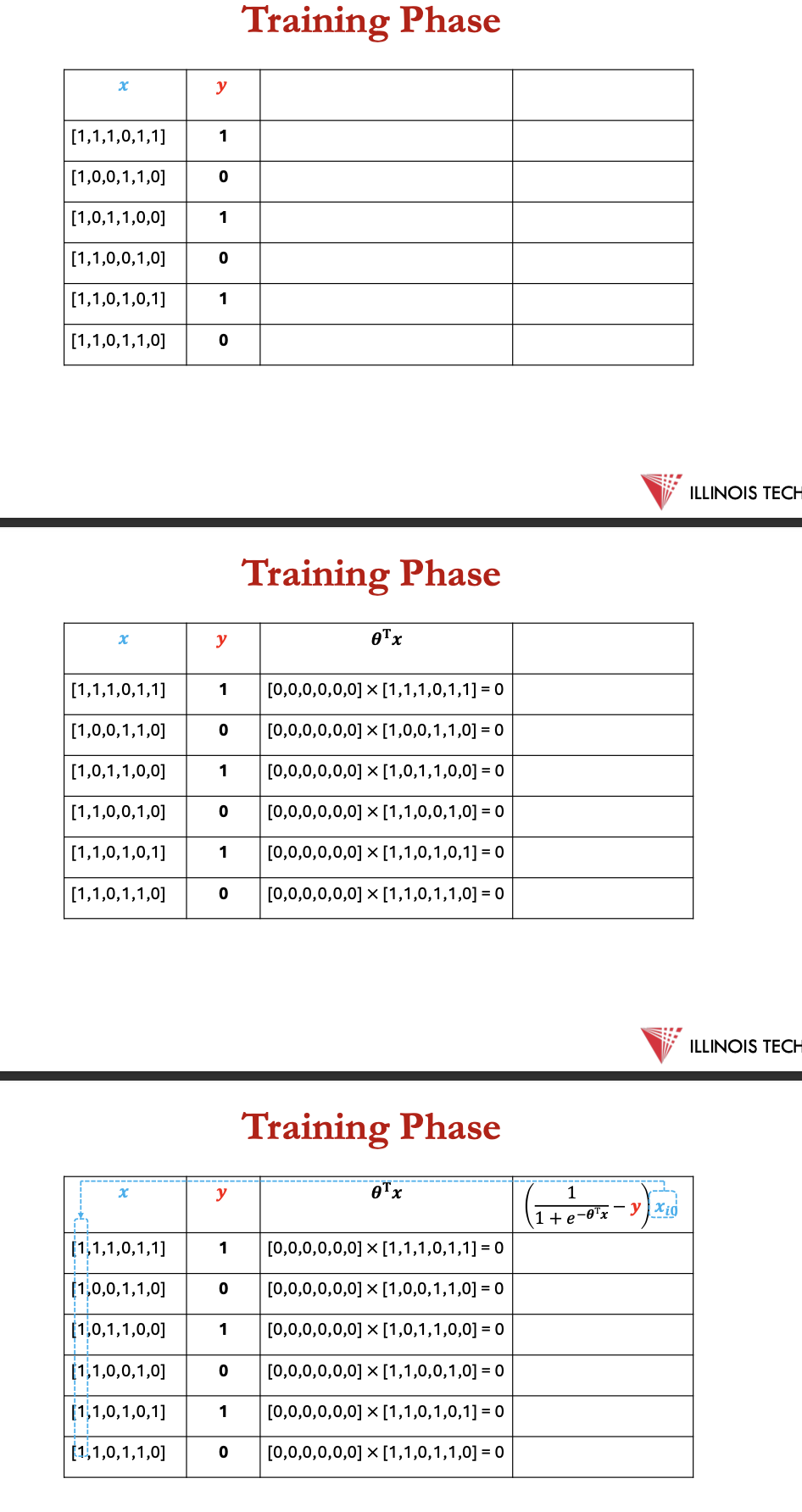
training phase
1st - calculate −𝜽T𝐱 for every example in the data set
2nd - calculate ∑ 𝐱𝑖𝑗 [ 1/ 1+𝑒−𝜽T𝐱−𝑦𝑖] for every example in data set for every 𝜽
3rd - compute every 𝜽𝑡+1
![<p>1st - calculate <sup>−𝜽T𝐱</sup> for every example in the data set</p><p></p><p>2nd - calculate ∑ 𝐱<sub>𝑖𝑗</sub> [ 1/ 1+𝑒<sup>−𝜽T𝐱</sup>−𝑦𝑖] for every example in data set for every 𝜽</p><p></p><p>3rd - compute every 𝜽<sub>𝑡+1</sub></p>](https://knowt-user-attachments.s3.amazonaws.com/d3b85f78-ecc1-4c9b-a4b1-f53db8b851e8.png)
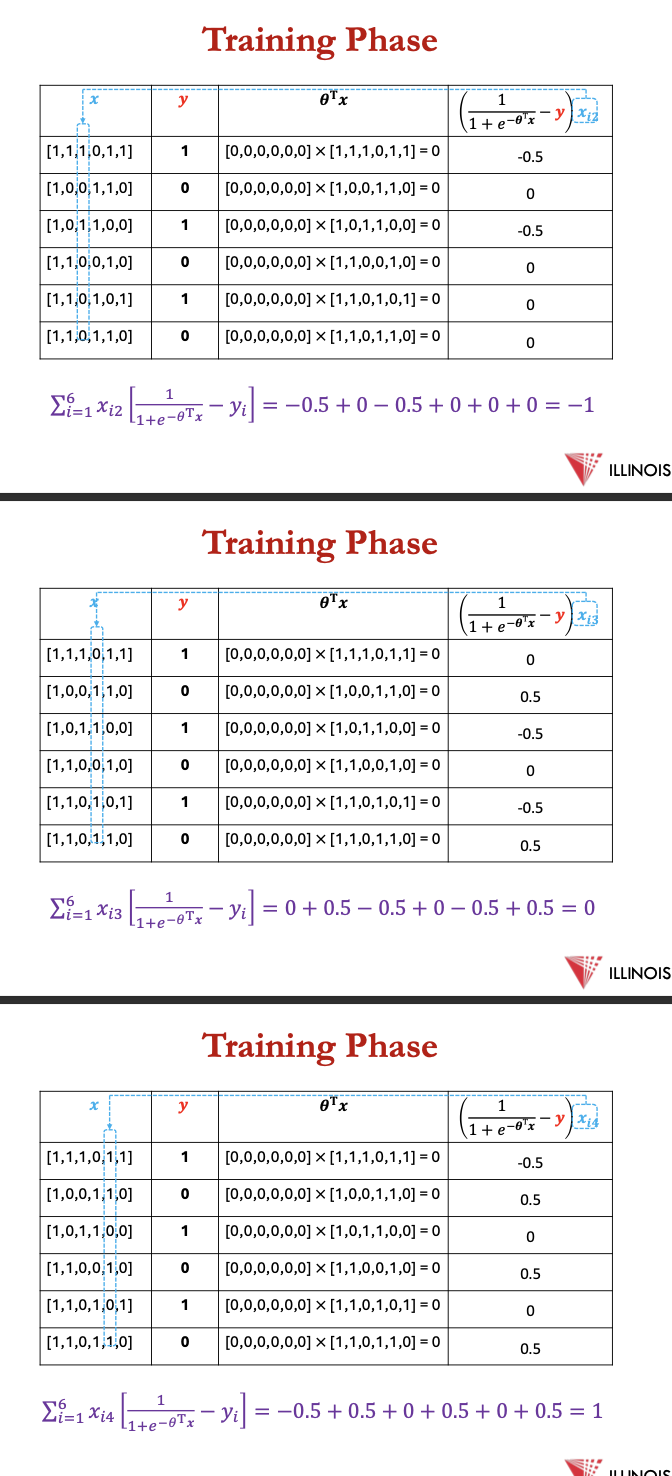
cont
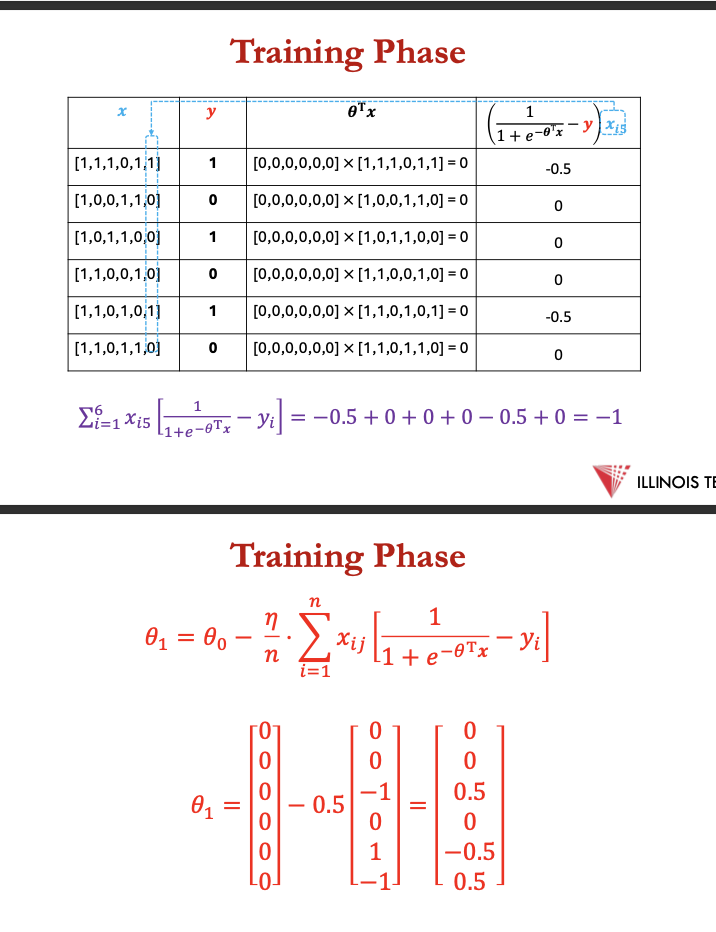
testing phase
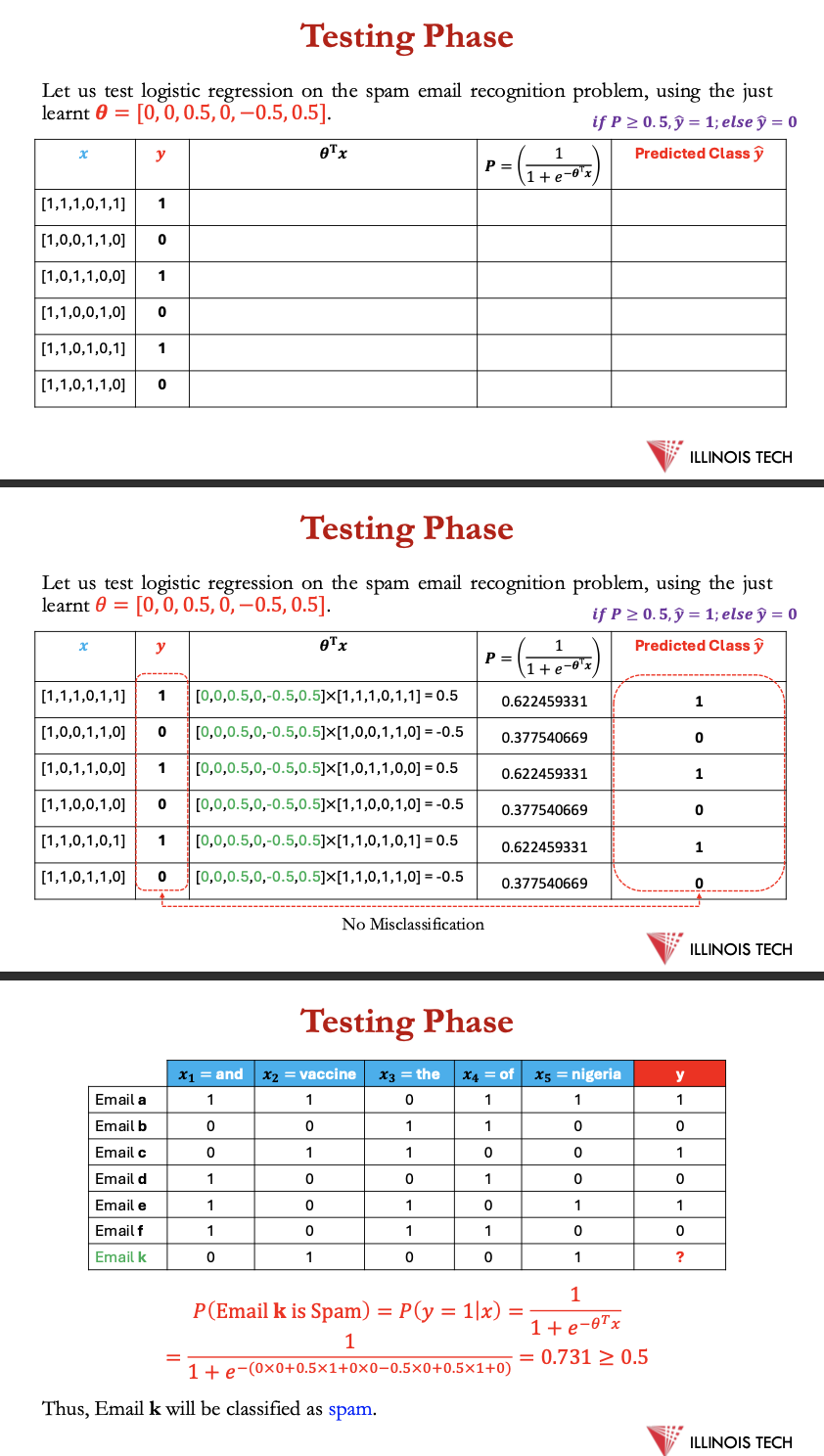
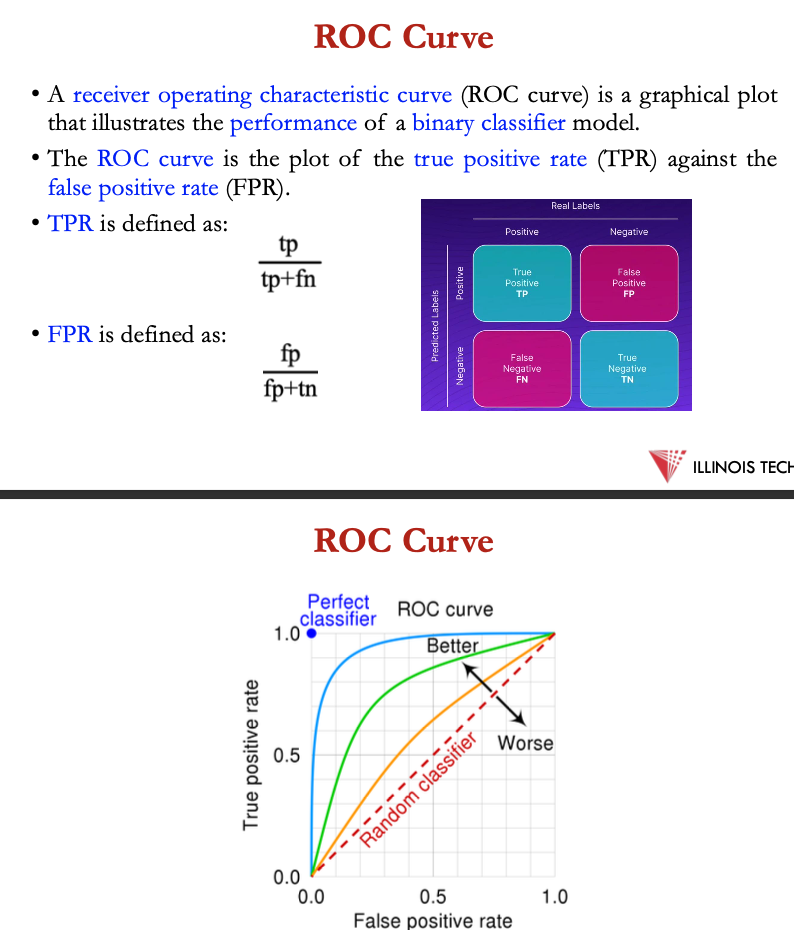
ROC curve
receiver operating characteristic curve = graphical plot that illustrates the performance of a binary classifier model
ROC curve = plot of the true positive rate against the false positive rate
TPR:
tp / (tp+fn)
FPR:
fp/ (fp+tn)
Classification threshold is used to convert the outputof a probabilistic classifier into class labels.
• The threshold determines the minimum probabilityrequired for a positive class
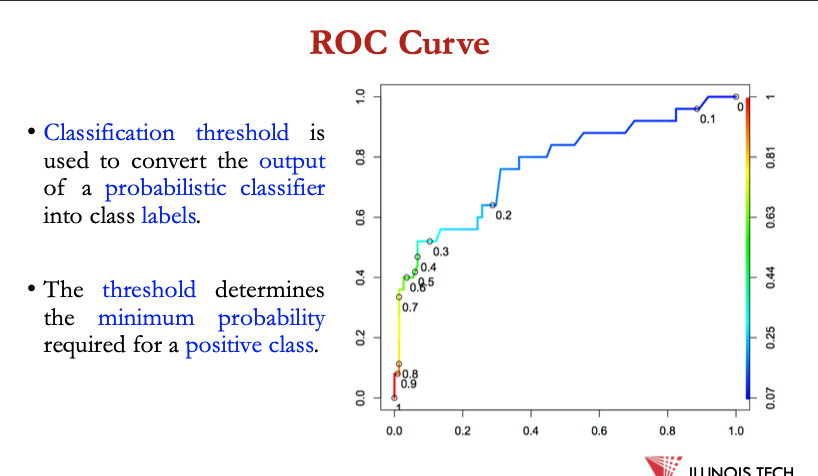
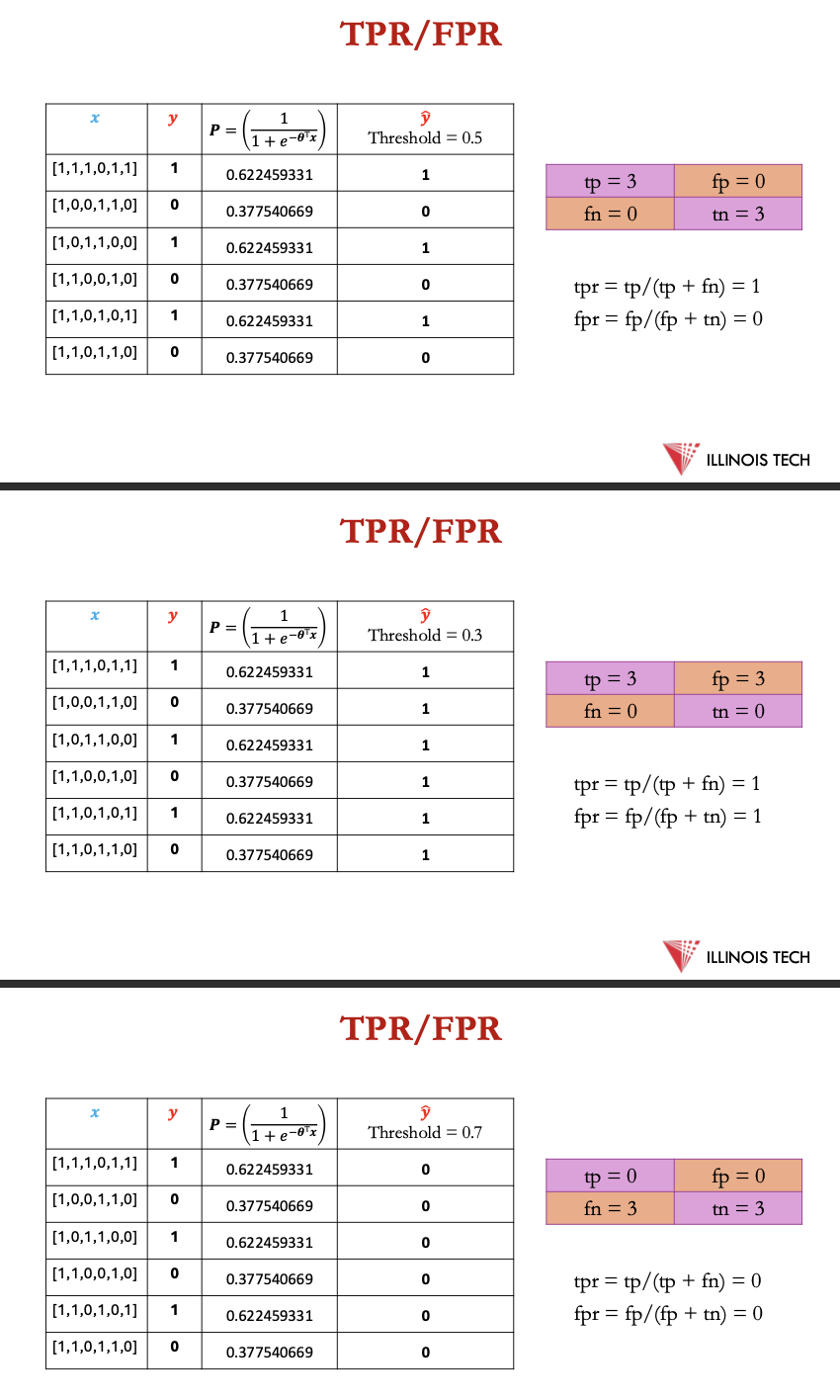
TPR/FPR
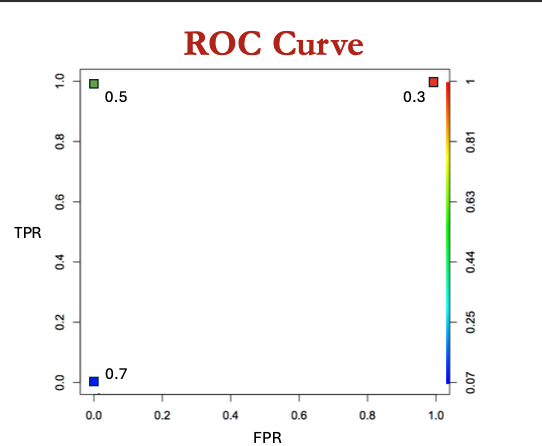
AUCa
area under the ROC curve provides aggregate measure of performance across all classification thresholds
between 2 ROC curves plotted based on 2 learning models, model w higher AUC learned better than the other
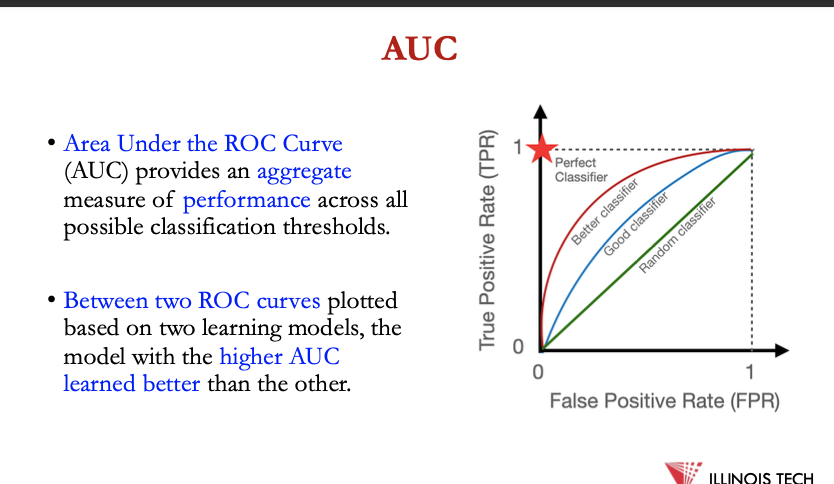
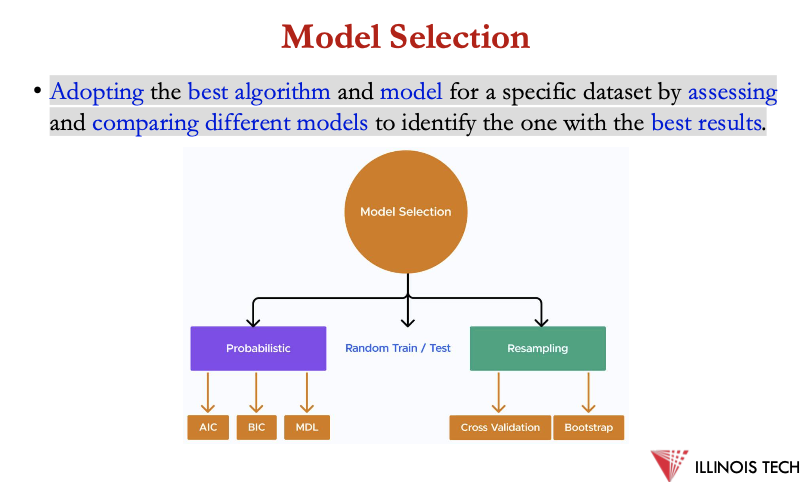
Model Selection
Adopting the best algorithm and model for a specific dataset by assessing and comparing different models to identify the one with the best results.
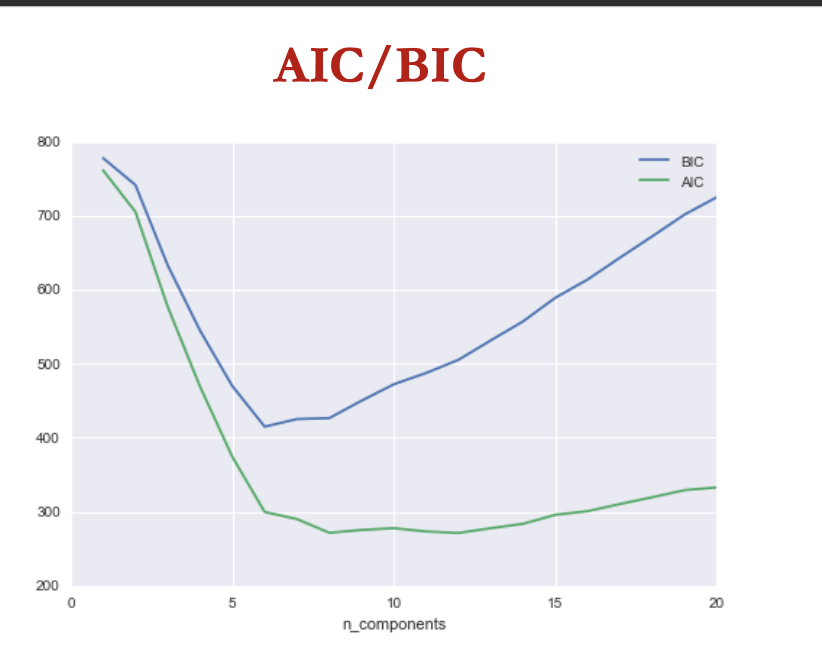
AIC/BIC
akaike info criterion + bayesian info criterion compares diff models to choose 1 that best fits the data
goal of both AIC + BIC = balnce the goodness of fit of the model w its complexity in order to void overfitting or underfitting
both AIC + BIC penalises models w large no of parameters relative to size of data, but BIC penalises more severely
min 𝐴𝐼𝐶 = 2 𝑚 − 2 log 𝐿
min 𝐵𝐼𝐶 = 𝑚 log 𝑛 − 2 log 𝐿
where m = no of model parameters, n = no of data points + L = max likelihood of the model
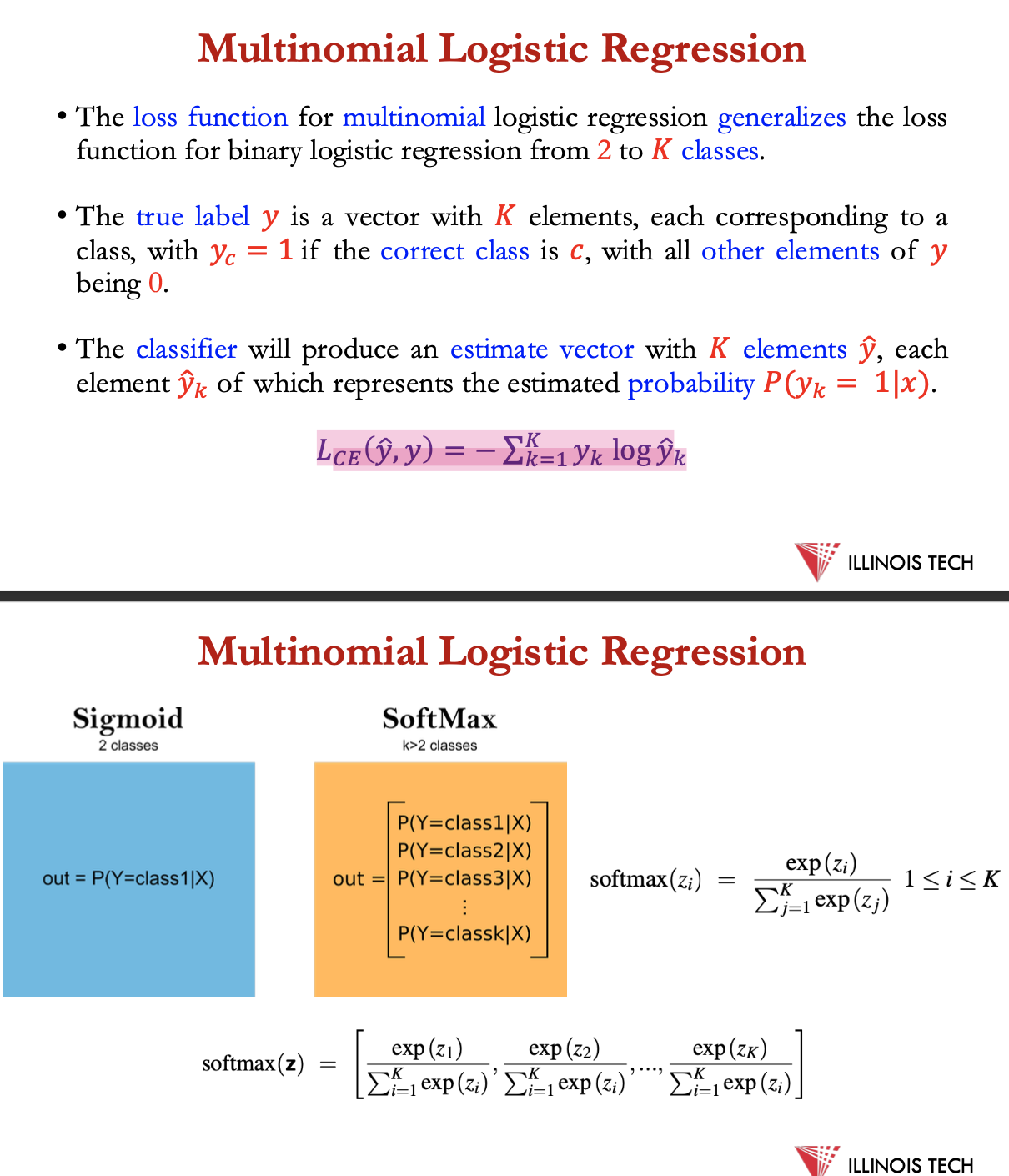
Multinomial Logistic Regression
loss function for multinomial LR generalises loss function for binary LR from 2 to K classes
true label y = vector with K elements, each corresponding to a class, with yc = 1 if the correct class is c, with all other elements of y being 0
classifier will produce estimate vector w K elements ŷ each element ŷk of which represents the estimated probability P(yk=1|x)
LCE(ŷ,y) = -∑ yk log ŷk
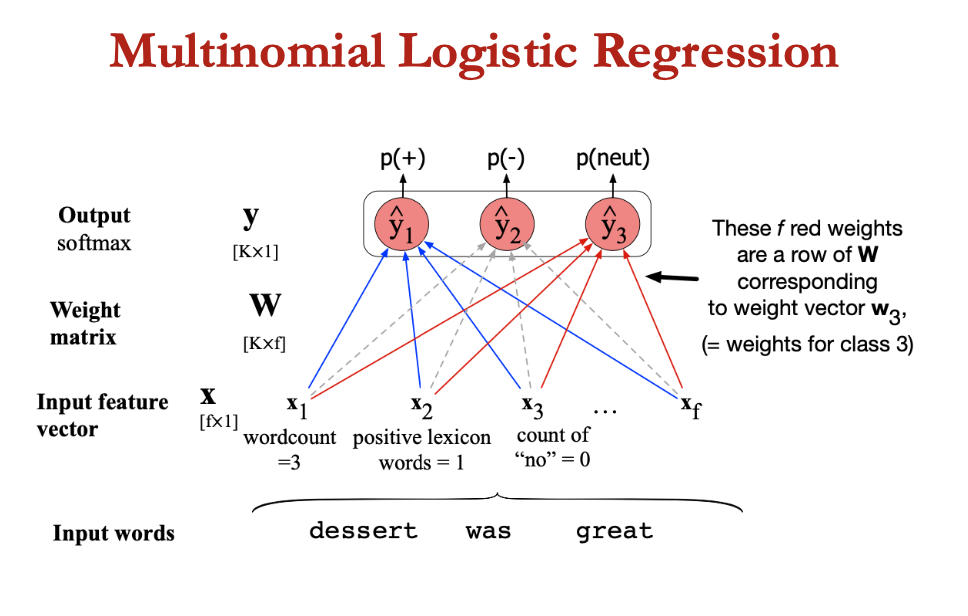
conclusion
Primarily used to estimate the probability of a specific outcome.
• Is a discriminative learning model.
• Is a linear classifier.
• Optimizes by minimizing the cross-entropy loss via gradient descent.
• Trains parameters:
oBegins with initial weight vector.
oModifies it iteratively to minimize the loss function.